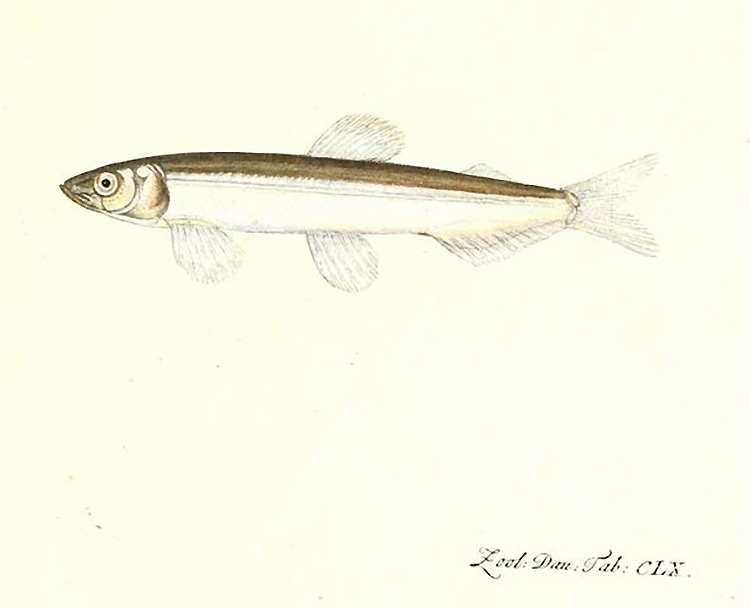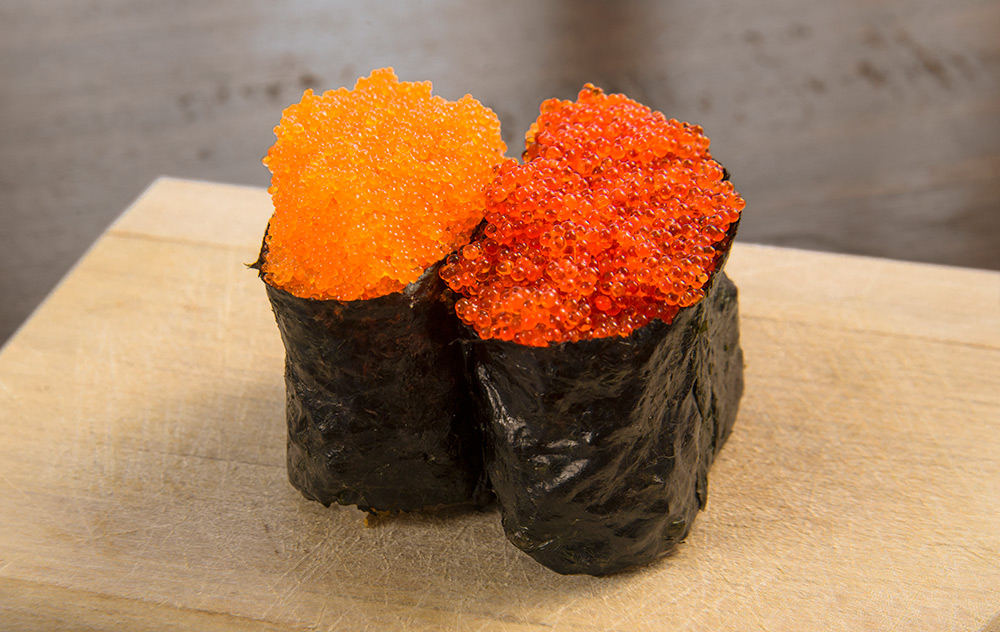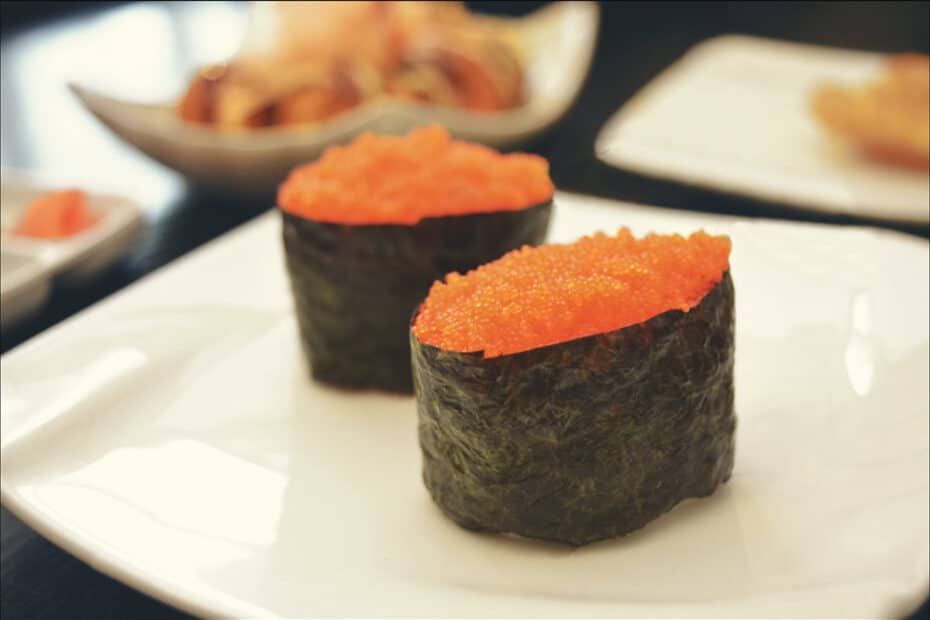Masago (まさご) is smelt roe and is a staple of Japanese restaurants. This post explores what it tastes like, the species used, sustainability, and more.
What is Masago?
Masago is smelt roe. In North America and Europe, masago is usually obtained from capelin. In Japan, masago is usually roe from the similar shishamo smelt and may be called shishamoko.
Masago (真砂) means sand, which is a reference to its appearance.
The roe is slightly smaller than flying fish roe (tobiko) and significantly smaller than salmon roe (ikura). It also has a duller color and a softer texture.
Masago is naturally translucent, and females produce from 6,000-14,500 eggs each.
Capelin is a species that inhabits the North Pacific, North Atlantic, and Arctic oceans. Most of the commercially caught capelin comes from the Atlantic.
Masago is typically cured with many ingredients other than just salt. Soy sauce, MSG, high fructose corn syrup, and food coloring agents are common.

What Does Capelin Roe Taste Like?
The first impression of masago is a crunchy texture. It pops slightly between teeth. But compared to the similar-looking tobiko, masago is softer.
Masago is slightly sweet, briny, and with a bit of a citrusy quality. It usually does not have a smoky flavor (unlike tobiko).
Overall, masago is excellent for sushi beginners because its flavor is mild.
Types of Masago
Just like tobiko, a bunch of commercially derived types of masago are produced. The main difference between them is usually the choice of food coloring.
Commercial masago is less likely to use natural ingredients like squid ink or beet as flavoring agents.
Orange Masago
This is the most common type. At most restaurants, if masago is listed on the menu, it will be the orange type.
Orange masago is very mild in flavor. It’s subtly sweet and salty with a bit of umami.
Orange masago gets its color from FD&C Yellow #6 food dye. Soy sauce, corn syrup, salt, and MSG are also usually added.
Black Masago
Black masago looks very similar to black tobiko. However, the smelt-based version is less likely to have squid ink. It also has a less flavorful taste. Its color comes from FD&C Yellow #5, Blue #1, and Red #40.
Like other commercial examples of capelin roe, black masago usually contains salt, soy sauce, high fructose corn syrup, and MSG.
Red Masago
Red masago tastes the same as its orange cousin. The primary difference is the use of FD&C Red #40 dye instead of Yellow #6.
Wasabi Masago
Wasabi masago uses wasabi or horseradish, for flavoring. Its color is derived from yellow and blue food dyes.
Salt, soy sauce, corn syrup, and MSG are typically used in the curing process of wasabi masago.
Where to Buy Masago
Capelin roe is easy to find in Japanese restaurants. But if you want to use it to make your own sushi at home, you’ll have to look a little harder.
Some Japanese markets sell frozen masago. Uwajimaya and Mitsuwa are two chains worth checking out. High-end seafood markets are also worth a shot.
But for most of the country, shopping online is the easiest, cheapest, and fastest way to buy masago.
Below are a few online retailers with quality roe. I’m an affiliate advertiser for some of them and may earn commissions on qualifying purchases.
Buy Masago Online

Other Fish Roe for Sushi
Masago is often used in place of tobiko, or flying fish roe. Tobiko is slightly larger, brighter, and firmer than masago. Learn more about tobiko vs masago here.
Ikura, or salmon roe, is the most popular type of fish egg one will encounter in a sushi restaurant. There are different types of salmon used for ikura, with different-sized eggs. But all of them are much larger than capelin eggs.
Interestingly, shrimp roe are the most similar to masago in appearance and flavor. Called ebiko in Japanese, shrimp roe are soft, dull orange, and inexpensive.
Serving Masago
Most often, masago is used on the outside of sushi rolls. But it can be used in other ways, some of them surprising.
Masago Sushi
Masago is frequently used as a substitute for tobiko. Superficially, it looks the same, so it can add a pop of color to sushi rolls and nigiri. However, masago doesn’t have the same crunchy texture as tobiko. This makes it a little less prized than tobiko sushi.
Masago is sometimes used on chirashi sushi.
And again like tobiko, masago is only occasionally served on its own as gunkanmaki. The more casual a sushi restaurant is, the more likely it would be a menu option.
Masago gunkanmaki is a great value and I highly recommend it.
It’s popular to add a quail egg to the gunkan. It enhances the flavor and texture. I definitely recommend you try it if you haven’t already!
Other Ways to Enjoy Capelin Roe
Masago makes a great addition to pasta and salads.
It can be used as garnishes and to add color to many western dishes. It looks especially good on top of raw oysters.
Similarly, masago sometimes finds its way into oyster shooters. However, ikura is more commonly used for this purpose.
Pairing Drinks and Masago Sushi
There are many types of alcoholic beverages that pair well with masago. These beverage pairings focus specifically on the fish roe. So the pairings work best with gunkan and sashimi presentations of masago.
Pairing Smelt Roe with Sake and Beer
Sake and fish eggs are a natural match. Just look for types of sake that aren’t too rich or savory.
Sparkling sake is a semi-sweet substyle that also tends to work well with masago – especially wasabi-infused masago.
Beer and fish roe are also a great combo. But again, stick to lighter beers like pilsners, pils, cream ales, etc. Sapporo Premium and Asahi Super Dry are readily available and ideal. But the other major Japanese lagers are a fine match too.
Wine Pairings with Smelt Roe Sushi
Wine and sushi can be a great match, and masago is no exception. Look for whites without heavy oak contact, sparkling wine, and rose. Grapes and regions to pair with masago gunkan include pinot gris (grigio), unoaked chardonnay, dry riesling, gruner veltliner, and Muscadet
Check out these foolproof sushi and wine pairings to elevate your next meal.
Shochu Pairings that Work
Vodka and caviar are a classic combination, so why not crisp, clean types of shochu?
Honkaku rice or barley shochu between 20-24% ABV can be a fantastic palate cleanser. Look for brands like Iichiko Silhouette, Kawabe, and Hakutake Shiro.
If you want a punchier flavor, lighter-flavored examples of sweet potato shochu and awamori can be a nice contrast.
Is Masago Good for You?
Masago is nutrient-rich, low-calorie, and low-carb. It’s also loaded with healthy fats like Omega-3 fatty acids. Additionally, masago is rich in protein, minerals, and vitamins. Vitamin B12 levels are especially high. Vitamin C and E levels are also somewhat high.
Mercury levels are also much lower than larger predatory fish like tuna and mackerel.
The major downside of masago is high levels of sodium. The use of salt, and sometimes soy sauce, only adds to their sodium levels. High fructose corn syrup is also commonly used for processing masago.
Is Masago Gluten Free?
Naturally, masago contains no gluten. However, many commercially available examples use soy sauce for curing. Soy sauce isn’t gluten-free, so be sure to check the label or ask the chef about the ingredients list.
Proper Storage of Masago
Smelt roe freezes well and doesn’t lose its texture or flavor. Once thawed, keep it refrigerated.
Thawed masago tastes best within 3 or 4 days.
Sustainability
Masago is produced from multiple species, with several commercial uses and fisheries across the globe. Pinpointing an exact answer is challenging, but we can get you close.
Is Masago Sustainable?
The majority of capelin, and therefore masago, are harvested in the Atlantic. The Monterey Bay Aquarium’s Seafood Watch lists these stocks as either certified or good alternatives.
Pacific stocks aren’t as heavily fished and information about their sustainability is hard to find.
The populations of capelin fluctuate dramatically from season to season. Capelin are also caught as bycatch in other fisheries. And finally, they’re highly sensitive to environmental changes. Capelin are susceptible to overfishing for these reasons.
Conclusion
Did I miss anything?! If you want to know more about masago, please let me know.
I’m also curious, have you used smelt roe at home? It’s easy to use in sushi rolls and nigiri. But have you tried it? And if so, any tips for everyone else?
Finally, if you want to master the sushi bar, check out my sushi and sashimi guide.

